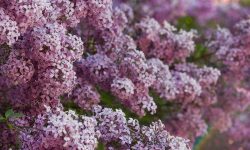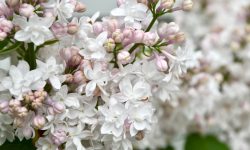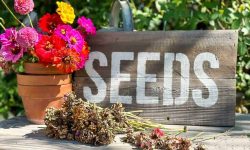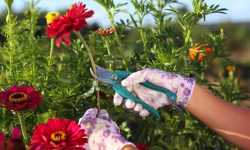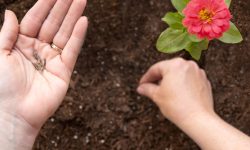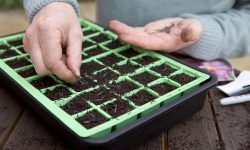Lobelia’s life cycle depends on the species and your growing zone. In cooler regions, it is most often grown as an annual, especially the popular Lobelia erinus, which thrives in spring and early summer but typically fades with heat or frost. However, in warmer climates—particularly USDA Zones 10 and 11—some varieties of lobelia can behave as short-lived perennials and may return the following year with proper care.
Perennial species like Lobelia cardinalis (cardinal flower) or Lobelia siphilitica (great blue lobelia) are more cold-hardy and return reliably year after year in the right conditions. These types also tend to be taller and better suited for perennial borders or naturalized gardens. Understanding whether your lobelia is a true perennial or an annual will help you plan maintenance, pruning, and propagation more effectively.
Is Lobelia a Perennial Plant?
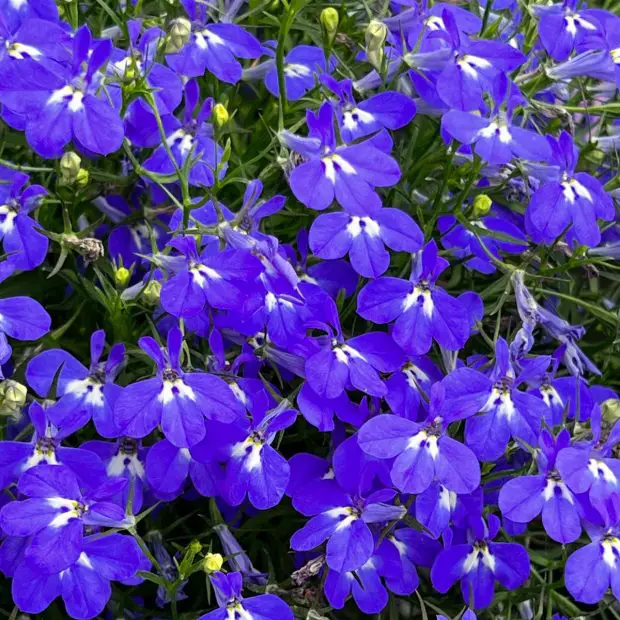
The Life Cycle of Lobelia
Lobelia plants grow in a variety of forms, and their life cycle is determined by their genetic makeup and environmental conditions. Annual lobelias germinate from seed, bloom throughout one growing season, and then die when cold weather arrives. They are ideal for adding bursts of seasonal color to containers and garden edges.
Perennial lobelias, on the other hand, enter dormancy during colder months but return in spring. These types develop deeper root systems that help them survive through winter, especially when properly mulched or protected. In Zones 7–9, some annual types may even reseed themselves or overwinter successfully with light frost protection, blurring the line between annual and perennial behavior.
Common Perennial Lobelia Varieties
Several lobelia varieties are true perennials and provide structure and long-lasting beauty to gardens over many seasons.
Lobelia cardinalis (Cardinal Flower) features vibrant red blooms and grows best in moist soils. It’s a favorite for pollinators, especially hummingbirds, and thrives in Zones 3–9. This variety is often found along streams and in rain gardens because of its water-loving nature.
Lobelia siphilitica (Great Blue Lobelia) bears tall spikes of blue flowers and prefers partially shaded spots. It performs well in Zones 4–8 and is excellent for naturalizing in woodland or meadow-style gardens.
Lobelia laxiflora (Mexican Lobelia) is native to the Southwest and produces reddish-orange tubular flowers. It is more drought-tolerant than other perennial types and is hardy in Zones 7–10. With time, it can form dense clumps and becomes a showy centerpiece in sunny borders.
Each of these perennial lobelias requires slightly different conditions to thrive, so selecting the right type for your climate and garden design is important.
Annual Lobelia Types
The most familiar type of annual lobelia is Lobelia erinus, which is prized for its compact size and trailing habit. It’s typically grown as a bedding plant or in containers, hanging baskets, and window boxes. Blooming profusely in cool weather, Lobelia erinus puts on a vibrant show of tiny flowers in deep blue, purple, rose, or white shades.
Because it cannot survive frost, this type is typically planted after the last spring freeze and blooms through summer. In hot climates, it may fade in mid-summer heat but can rebound with trimming and cooler temperatures in fall. In Zones 9–11, gardeners sometimes treat Lobelia erinus as a short-lived perennial by overwintering it indoors or providing frost protection.
Hybrid cultivars such as ‘Riviera Blue’, ‘Crystal Palace’, and ‘Regatta Marine Blue’ offer diverse colors and improved heat tolerance. These annual varieties are best started from seed indoors or purchased as transplants in spring for quick results.
Understanding Lobelia’s Hardiness by Region
USDA Zone Recommendations
The behavior of lobelia as a perennial or annual varies significantly based on your USDA hardiness zone. In Zones 7 through 10, perennial species like Lobelia cardinalis and Lobelia siphilitica can typically survive mild winters and reemerge in spring. These regions offer the ideal combination of soil warmth and frost-free winters that support root survival and continuous growth. However, in Zones 3 to 6, lobelia may be treated as an annual because prolonged freezing can damage or kill even hardy perennial roots.
In these colder zones, gardeners often choose to grow lobelia as an annual for reliable summer color. Alternatively, you can experiment with microclimates, such as planting near foundations or walls that retain heat, which may extend the plant’s life. Knowing your zone and selecting varieties that match your local conditions will significantly improve your success with growing lobelia.
Overwintering in Colder Climates
To preserve perennial lobelia in colder regions, overwintering techniques are essential. After the first frost, you should cut back the foliage and apply a thick mulch layer—around 3 to 4 inches—over the root zone. This insulation helps shield roots from extreme cold and frost heaving. Use organic mulches like shredded leaves, pine needles, or straw, which also improve soil health as they decompose.
For lobelia grown in containers, it’s best to move the pots indoors before hard frost arrives. Store them in a cool but frost-free garage, basement, or enclosed porch with indirect light. Reduce watering during dormancy, just keeping the soil barely moist to prevent complete drying out. In spring, remove the mulch or bring containers back outside after all danger of frost has passed. These overwintering steps can make the difference between losing your lobelia and enjoying their vibrant return year after year.
How to Grow Lobelia Successfully
Choosing the Right Variety
Success with lobelia starts by matching the variety to your needs and local conditions. For long-term garden impact, perennial species like Lobelia cardinalis (cardinal flower) and Lobelia siphilitica (great blue lobelia) offer season-after-season performance, especially in USDA Zones 4–9. These varieties also attract pollinators like hummingbirds and butterflies. If you’re planting in containers, borders, or hanging baskets and want quick, vibrant blooms, annual varieties such as Lobelia erinus are a great choice. Their cascading growth and intense blues, purples, and whites make them ideal for seasonal color.
Soil and Light Requirements
Lobelia thrives in fertile, moisture-retentive soil that drains well. Enrich the planting area with compost or organic matter before planting to improve both fertility and structure. While lobelia prefers full sun in cooler climates, it performs better with some afternoon shade in regions with intense heat. Too much sun combined with dry soil can lead to stress and reduced flowering. In shaded areas, ensure good air circulation to prevent fungal issues like powdery mildew.
Planting Time and Method
Timing is key when planting lobelia. Wait until all danger of frost has passed and the soil has warmed in spring. In colder climates, you can give annual lobelia a head start by sowing seeds indoors 8–10 weeks before the final frost. Use a seed-starting mix and provide light to promote germination. For perennial types, consider planting nursery-grown starts or divisions in spring or early fall. Space plants according to variety—compact types may be spaced 6 inches apart, while taller varieties need more room to grow and spread.
Watering and Fertilization
Lobelia prefers evenly moist soil but is sensitive to waterlogging and drought. Water regularly, especially during dry periods, to keep the roots cool and hydrated. Avoid letting the soil dry out completely, which can cause stress and halt blooming. Container-grown lobelia may require daily watering in summer. Apply a balanced liquid fertilizer every 3–4 weeks during the growing season to encourage continuous flowering. For perennials, reduce fertilization by late summer to help the plants prepare for dormancy. Mulching can also help retain moisture and suppress weeds around your lobelia.
Seasonal Lobelia Care Tips
Spring Maintenance
As winter recedes and temperatures begin to warm, spring marks a critical time for setting your lobelia up for a vibrant growing season. Start by removing any old mulch, fallen leaves, and withered stems left over from the previous year. This allows for better air circulation and reduces the risk of fungal diseases. Inspect perennial varieties for emerging shoots at the base—these are signs of healthy regrowth. Apply a balanced, slow-release fertilizer (such as 10-10-10) to support strong root development and early foliage growth. Begin a regular watering schedule, especially if spring rains are scarce, keeping the soil evenly moist but not waterlogged. If growing from seed, this is the ideal time to sow lobelia indoors or directly into the ground after the last frost date.
Summer Growth and Blooming
Summer is the season when lobelia reaches its peak, offering lush growth and continuous blooms. During this time, lobelia is highly dependent on consistent moisture. Water deeply several times a week, particularly in containers where the soil dries out more quickly. To prevent wilting or stress during heatwaves, consider watering early in the morning or in the evening when evaporation rates are lower. Apply a diluted liquid fertilizer every two to three weeks to fuel blooming. Deadheading—removing spent flowers—will encourage the plant to produce new buds instead of going to seed. If your lobelia starts to look leggy or sparse, trim it back by a third to promote bushier, more compact growth. This simple step can lead to a fresh flush of flowers by mid to late summer.
Fall Preparation
As temperatures begin to cool and daylight shortens, lobelia naturally slows its growth. Annual varieties may begin to fade entirely, while perennials prepare to go dormant. For perennial lobelias, pruning back spent flower stalks and any damaged or dying stems will help tidy the plant and reduce the spread of pests or disease. Now is the time to reduce watering slightly, allowing the plant to gradually enter dormancy. In regions with freezing winters, apply a thick layer of organic mulch—such as straw, shredded bark, or compost—around the base to insulate the roots from sudden cold snaps. If you’re growing lobelia as an annual and want to save seeds, collect them from mature, dry flower heads before the first hard frost. Store seeds in a paper envelope in a cool, dark place for next year’s planting.
Winter Protection
Although lobelia is often grown as an annual, some species and cultivars are hardy perennials in USDA zones 6 through 10. These perennial types require proper winter protection to survive until spring. Start by ensuring that the plant is well-mulched in late fall, as a thick blanket of mulch will help regulate soil temperature and moisture during the cold months. In areas with harsh winters or repeated freeze-thaw cycles, consider covering the base of the plant with evergreen boughs or using frost cloth for extra insulation. For lobelia growing in containers, the roots are more vulnerable to freezing. Move pots into an unheated garage, shed, or cold frame where they’re sheltered from wind and frost. If you live in a zone where lobelia cannot overwinter outdoors, treat it as an annual or dig up the roots of perennial varieties and store them in slightly moist peat moss in a cool, frost-free place until replanting in spring. Regularly check stored roots for mold or rot and discard any that show signs of decay.
Propagating Lobelia
Seed Propagation
Growing lobelia from seed is a rewarding method, particularly for annual varieties like Lobelia erinus. Start seeds indoors 8 to 10 weeks before your area’s last expected frost date. Since lobelia seeds are tiny and require light to germinate, sprinkle them on top of moist seed-starting mix without covering them with soil. Use a spray bottle to keep the surface evenly moist and place the seed tray under bright fluorescent lights or near a sunny window. Maintain temperatures between 65 and 75°F for the best germination results.
Seedlings typically sprout within 10 to 21 days. Once they develop a few sets of true leaves, thin them gently or transplant them into larger containers. Harden them off before transplanting outdoors. Keep in mind that hybrid lobelias may not grow true to type from seed, so save this method for open-pollinated varieties or when exact characteristics aren’t essential.
Division and Cuttings
Perennial species like Lobelia siphilitica and Lobelia cardinalis can be propagated through division, a method ideal for rejuvenating older clumps and expanding your garden without starting from scratch. The best times for dividing are early spring, just as new growth appears, or in early fall when the weather begins to cool.
To divide, dig up the entire root ball carefully and gently pull or cut apart sections that have healthy roots and shoots. Replant these divisions promptly in a well-prepared bed, keeping them well-watered for the first few weeks to help them establish.
Stem cuttings are another effective way to propagate lobelia, particularly in warm climates or greenhouses. Choose non-flowering shoots from healthy plants and cut sections 3 to 5 inches long. Remove the lower leaves and dip the cut end in rooting hormone before planting in a moist, sterile potting mix. Cover the cuttings with a humidity dome or plastic bag to maintain moisture and place them in indirect light. Roots typically develop within two to three weeks.
Common Problems and Solutions
Pests and Diseases
While lobelia is generally considered low-maintenance and resilient, it is not immune to pest and disease issues, especially when growing conditions are less than ideal. Aphids can cluster on tender stems and buds, sucking sap and distorting new growth. Slugs and snails are common problems for lobelia grown in moist, shaded areas and may chew holes through leaves and flowers. Spider mites may appear during hot, dry periods, causing stippling or bronzing of foliage.
In terms of disease, lobelia is vulnerable to fungal infections, particularly when air circulation is poor or leaves remain wet for extended periods. Root rot is a common concern in containers or poorly drained soil, while powdery mildew may develop in humid conditions. Prevent these issues by ensuring the plant receives adequate airflow, avoiding overhead irrigation, and using well-draining soil. Removing infected plant parts promptly can help prevent the spread of pathogens.
Troubleshooting Poor Blooming
Lobelia is prized for its vibrant, continuous blooms, so it can be disappointing when the plant stops flowering. A few common culprits may be to blame. Insufficient sunlight can severely reduce blooming, especially in perennial varieties that prefer at least partial sun. Overly dry soil can also cause flower production to slow down or cease altogether, particularly in summer when plants require more frequent watering.
A lack of nutrients may lead to sparse foliage and limited blooms. Lobelia performs best when fed every few weeks with a balanced or phosphorus-rich fertilizer during its active growing season. Additionally, if the plant becomes leggy or crowded, it may focus more on stem and leaf growth than producing flowers. Prune it back lightly to encourage bushier, flower-heavy growth. Removing spent blooms (deadheading) also helps prolong flowering.
Heat Stress in Summer
Lobelia thrives in cool conditions and may falter in intense summer heat, particularly annual varieties like Lobelia erinus. As temperatures rise above 85°F (29°C), plants can become leggy, lose their vibrant color, or even stop flowering altogether. This decline often discourages gardeners, but the good news is that lobelia can usually recover with proper care.
To address heat stress, cut back the affected plant by about one-third to remove tired foliage and stimulate new growth. Increase watering frequency, especially for container-grown plants, to help the roots stay cool and hydrated. Applying mulch around the base can reduce soil temperature and retain moisture. In extreme heat, consider relocating potted lobelia to a spot with afternoon shade. With this support, many plants will bounce back and resume blooming as temperatures cool down in late summer or early fall.
Designing with Lobelia in the Garden
Pairing with Other Plants
Lobelia’s intense blue, purple, or white flowers add a vivid pop of color that complements many other garden favorites. In seasonal flower beds, it looks striking next to petunias, impatiens, and begonias—plants that share similar moisture and light requirements. The contrast between lobelia’s bold tones and soft pastel shades or silvery foliage creates visual harmony and dynamic interest. In perennial borders, lobelia blends beautifully with low-growing ferns, bright heuchera, and trailing sedums. These combinations bring a natural, layered effect while enhancing both color and texture throughout the season.
Using in Containers and Borders
Lobelia’s trailing varieties are excellent for hanging baskets and patio containers, where their cascading growth spills over edges like living waterfalls of color. When paired with upright bloomers such as geraniums or salvia, they provide a softening effect that makes arrangements feel more balanced and inviting. In garden borders, compact lobelia plants work well as colorful edging or filler between taller perennials like coneflowers or black-eyed Susans. Mixing upright and trailing lobelia within the same bed adds movement and structure, creating vibrant focal points from early summer through fall.
Indoor Care for Lobelia
Growing Lobelia Indoors
Although lobelia is more commonly grown outdoors, it can adapt to indoor environments when given proper care. Choose a bright location with at least 6 hours of sunlight daily, such as a south-facing window. If natural light is limited, supplement with full-spectrum grow lights to support healthy growth and flowering. Lobelia prefers cool indoor temperatures between 60–70°F (15–21°C), so avoid placing it near heat vents or drafty windows. To maintain the humidity it loves, place the pot on a pebble tray with water or use a humidifier nearby. Keep the soil evenly moist but never soggy, and ensure good drainage to prevent root rot. Regularly pinch back leggy stems to encourage fuller growth indoors.
Transitioning Between Indoor and Outdoor
When moving lobelia between indoor and outdoor spaces, especially at the beginning or end of the growing season, proper acclimatization is crucial. Sudden changes in temperature, light, or humidity can stress the plant, leading to wilting or leaf drop. Begin by placing your indoor lobelia in a sheltered outdoor area with indirect light for 2–3 hours a day. Gradually increase the exposure to direct sunlight and outdoor conditions over 7–10 days. This hardening-off process helps the plant adjust naturally to its new environment. When bringing it back indoors for overwintering, reverse the process to avoid shock and pest infestations. Always inspect the plant for pests like aphids or mites before transitioning.
FAQ About Growing Lobelia Indoors
Is Lobelia a Perennial Plant?
Lobelia can be either an annual or a perennial depending on the species and climate. The popular bedding variety Lobelia erinus is typically grown as an annual, especially in cooler regions where it doesn’t survive frost. However, species like Lobelia cardinalis and Lobelia siphilitica are true perennials and will come back each year in zones 4–9 with the right care.
How Much Sun Does Lobelia Need to Thrive?
Lobelia grows best in full sun to partial shade. In cooler climates, it flourishes with at least 6 hours of sunlight per day. In warmer zones, some afternoon shade can prevent the plant from wilting or developing heat stress during peak summer months.
Why Is My Lobelia Turning Brown or Wilting?
Browning leaves or wilting lobelia can result from underwatering, poor drainage, or too much heat. Check the soil moisture regularly and ensure it’s well-drained. During hot spells, increase watering and consider moving container plants to partial shade.
Can I Grow Lobelia in Pots or Hanging Baskets?
Yes, lobelia performs beautifully in containers and hanging baskets. Trailing varieties, in particular, spill gracefully over the edges, creating a vibrant, cascading effect. Make sure pots have drainage holes and use a lightweight, moisture-retentive potting mix for best results.
How Do You Get Lobelia to Bloom All Summer?
To keep lobelia blooming through summer, deadhead regularly and trim leggy growth mid-season. Feed the plant every 2–3 weeks with a balanced liquid fertilizer and water consistently, especially during dry or hot periods. Cutting back by one-third in midsummer can also encourage a second flush of blooms.
Final Thoughts on Growing Lobelia
Whether grown as a perennial or annual, lobelia offers a wealth of beauty for gardens, patios, and indoor spaces. Understanding the differences between species, their seasonal needs, and how to care for them properly ensures lasting enjoyment and vibrant displays.
With the right care and attention, lobelia will thrive in your garden year after year—or season after season—bringing continuous color and charm to your landscape.

